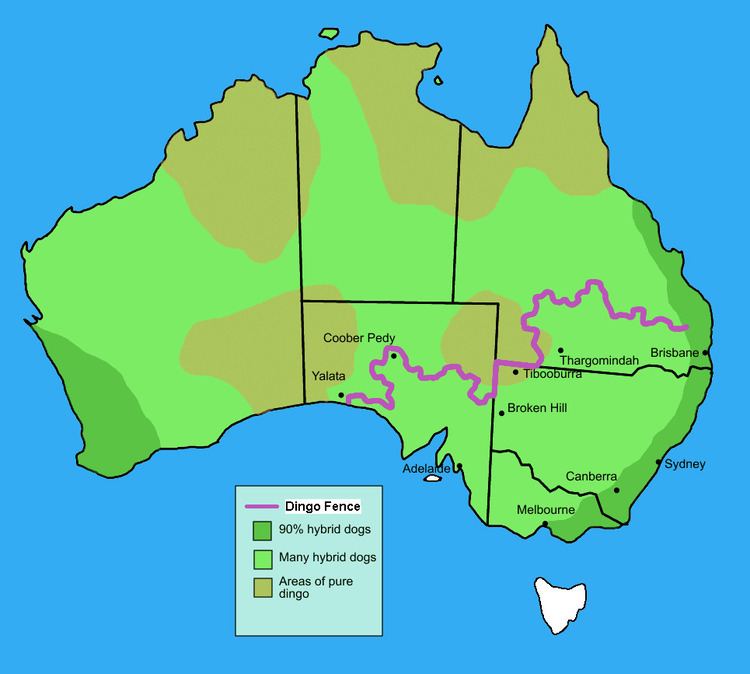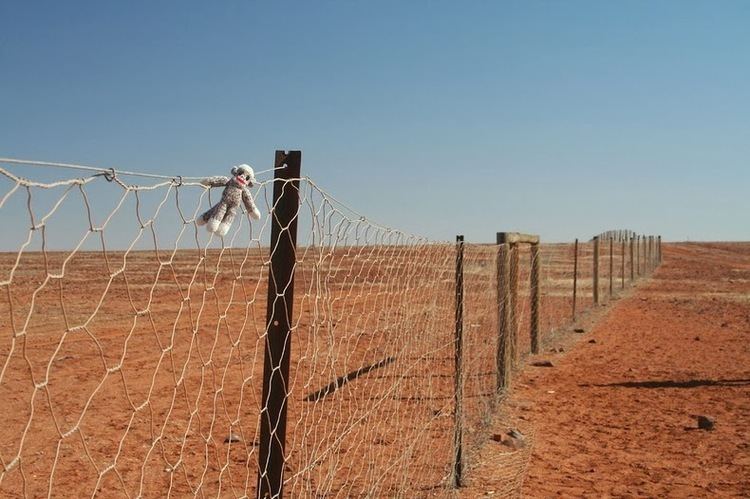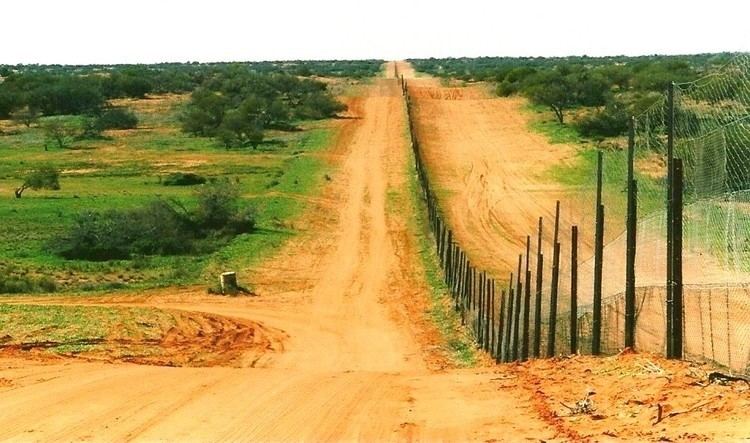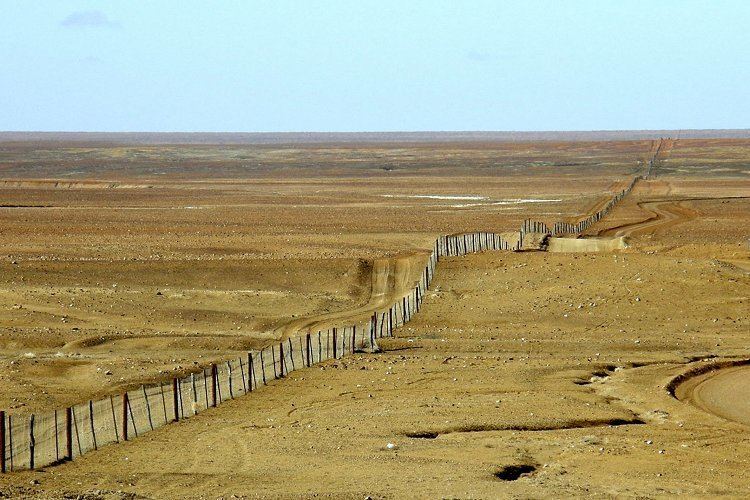 | ||
The louis show great dingo fence
The Dingo Fence or Dog Fence is a pest-exclusion fence that was built in Australia during the 1880s and finished in 1885, to keep dingoes out of the relatively fertile south-east part of the continent (where they had largely been exterminated) and protect the sheep flocks of southern Queensland. It is one of the longest structures in the world and is the world's longest fence. It stretches 5,614 kilometres (3,488 mi) from Jimbour on the Darling Downs near Dalby through thousands of kilometres of arid land ending west of Eyre peninsula on cliffs of the Nullarbor Plain above the Great Australian Bight near Nundroo. It has been partly successful, though dingoes can still be found in parts of the southern states. Although the fence has helped reduce losses of sheep to predators, this has been countered by holes in fences found in the 1990s through which dingo offspring have passed and by increased pasture competition from rabbits and kangaroos.
Contents
- The louis show great dingo fence
- The start of the dingo fence
- Geography
- Physical design
- History
- Environmental impact
- References

The start of the dingo fence
Geography

The 2,500 km (1,553 mi) section of the fence in Queensland is also known as the Great Barrier Fence or Wild Dog Barrier Fence 11. It is administered by the Department of Natural Resources and Water. The Wild Dog Barrier Fence staff consists of 23 employees, including two-person teams which patrol a 300 km (186 mi) section of the fence once every week. There are depots at Quilpie and Roma.

The Queensland Border Fence stretches for 394 km (245 mi) westwards along the border with New South Wales, into the Strzelecki Desert. The fence passes the point where the three states of Queensland, New South Wales and South Australia meet (Cameron Corner). At this point, it connects with the South Australian Border Fence, which runs for 257 km (160 mi) southwards along the border with New South Wales. It then joins a section known as the Dog Fence in South Australia, which is 2,225 km (1,383 mi) long.
Physical design

The fence varies in construction. Mostly it is made of 180 cm (5.9 ft) high wire mesh but some sections in South Australia comprise multi-strand electric fence. The fence line on both sides is cleared to a 5 m (5.5 yd) width. Sheep and cattle stations in Australia protected by the fence are astoundingly large. While varying in size, some stations can be larger than some small European countries. One station alone in South Australia lost over 11,000 sheep in a year due to dingo attacks before the completion of the fence. As recently as 1991, one station lost 3000 sheep in a year. Sheep farmers fought back by using poisoning, shooting, and eventually constructing the longest fence in the world. Aerial poison bait drops are still used today.

Parts of the Dingo Fence are lit at night by 86 mm (3.4 in) cold cathode fluorescent lamps which are alternately red and white. They are powered by long life batteries which are charged by photovoltaic cells during the day. At minor and farm crossings, a series of gates allow vehicles to pass through the fence. Where the fence intersects major roads and highways, Cattle grids are used to allow high-speed vehicles through.
History

The earliest pest exclusion fences in Australia were created to protect small plots of cropland from the predation by marsupials. In the 1860s and 1870s, introduced rabbit populations began to spread rapidly across southern Australia. By 1884, a rabbit-proof fence was built. Having been unsuccessful at keeping rabbits out, and more successful at keeping out pigs, kangaroos, emus and brumbies, and as more sheep farms were established, the interest for a dingo-proof barriers increased enough that government funds were being used to heighten and expand the fence. In 1930, an estimated 32,000 km of dog netting in Queensland alone was being used on top of rabbit fences. Prior to 1948, the idea of a Dingo Barrier Fence Scheme had not come into fruition as a statewide project for which annual maintenance and repair were kept. Since this time, there have been pushes to move away from a method of barrier-exclusion to complete extinction of the dingo and wild-dog cross-breeds. Poisoning the species with compound 1080 (sodium monofluoroacetate) baits has been seen as a much cheaper alternative than fence maintenance. A compromise in the form of the continued use of poison and the shortening of the fence from its previous length of over 8000 km has been made.
Environmental impact
It seems that there are fewer kangaroos and emus on the northwestern side of the fence where the dingoes are, suggesting that the dingoes' presence reduces the populations of those animals. It has also been suggested that the larger kangaroo populations inside the fence have been caused by the lack of dingo predation, and competition for food leads to lower sheep stocking rates than would be possible without the fence.
Believed to have been introduced into Australia by Aborigines between 4,600 and 18,300 years ago, the dingo's status as a native or introduced species in Australia has been a controversy. According to Dr. Mike Letnic, at the Centre for Ecosystem Science, UNSW, the dingo, as Australia's top predator, has an important role in maintaining the balance of nature and that reintroduced or existing dingo populations could increase biodiversity across more than 2 million square kilometres of Australia (Avolia 2009). Where dingoes had been exterminated, Dr. Letnic found increased abundances of introduced red foxes and herbivores, while small native mammals and grasses were lost. In 2011 the Liberal MP for Stuart, Dan van Holst Pellekaan, called for a $200 bounty on dingos.
Although the fence has helped reduce the loss of sheep to predators, the exclusion of dingoes has allowed for increased pasture competition from rabbits, kangaroos and emus. Sheep are being lost to increasing numbers of feral dogs.
Today, the rate at which feral camel are smashing down sections of the fence is fast increasing in Southern Australia. Plans for restructuring the Dog Fence to be taller and electric are in the works.
